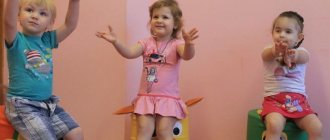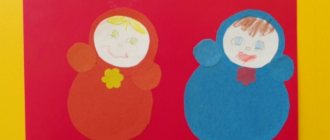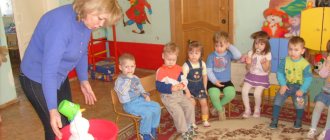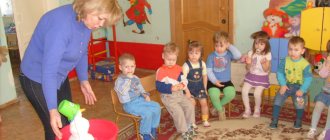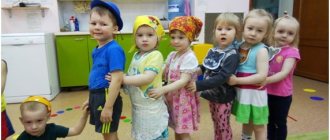The nursery group of a kindergarten is usually attended by children from 2 to 3 years old. Psychologists consider this age to be the most dynamic and productive stage of development. Children learn to speak, express their feelings in words, acquire their first self-care skills, and learn about the world around them. Play is their main activity, and toys are an important learning tool. The further development of children depends on how correctly they are selected. We will tell you in our article which games are suitable for a nursery group in a kindergarten.
Features of games for kindergarten children
Play activities in preschool educational institutions determine the direction of the physical, intellectual, and psychological development of children. In addition, they form the strong-willed and moral qualities of the child and reveal his creative potential. Games for the nursery group have a number of features that are expressed in the goals and techniques used by teachers to implement them.
The mission of games for children attending nurseries combines three areas:
- Didactic (educational). For example, when changing clothes for a doll, kids learn the name of items of clothing, the order of putting them on/taking off, and their correspondence to the weather and seasons. And by putting puzzles together, they get to know animals, vegetables, and fruits. The “clean tables day” announced in kindergarten teaches children to eat carefully.
- Developmental. The fundamental goal of educational games and exercises for kindergartens is speech training. Kids should not only “talk”, but also work on improving this skill. No less important is the effect of toys on memory, attention, thinking, imagination, and stimulation of cognitive activity.
- Educational. At 2-3 years old, children must learn patience, proper communication, cooperation, and acquire correct moral ideas. Another important skill that students acquire during play activities is self-regulation or extinguishing negative emotional impulses.
To successfully implement the goals and objectives, educators adhere to certain principles when organizing play activities.
Among them:
- Easy to understand. So, children are not yet able to lay out mosaics or puzzles consisting of a dozen fragments. But repeating a finished drawing with elements of toys is quite an accessible activity.
- Dynamism. Children attending nurseries can maintain attention for no more than 10 minutes. This feature dictates a regular change of activities.
- Visibility. For the fun to be as useful as possible, kids need to see the actions that they will perform in the future. They are offered thematic pictures, presentations, and a preliminary “playing out” of the scenario by the teacher.
- Goodwill. A good mood and a kind attitude from an adult are a prerequisite for joint entertainment.
- A combination of collectivity and individuality. Peculiarities of age do not yet allow organizing a full-fledged collective game. It is replaced by performing a single task, but by each student individually.
- Competitiveness. Until the age of 3, children do not understand what competition is. The teacher introduces this concept gradually, first through a general assessment of the group, then identifying the most successful participant.
An approximate list of toys for children in the nursery group of a kindergarten can be found in the corresponding document of the Department of General Education of the Ministry of Education and Science of Russia. We offer a selection of exciting, useful activities. And at the end of the article we will present the TOP toys you need.
Tips and tricks for relief
First of all, the parent must mentally prepare the child for visiting kindergarten - tell him that there will be a lot of fun and interesting things there, that he will be able to make real friends, learn, and learn something new.
It is advisable to increase the time spent in the group gradually , trying not to leave the baby last when evening comes. During the adaptation period, it is important for the child to have some kind of reminder of home nearby - this could be a favorite toy, a memorable photo, or any other little thing associated with the parents.
On the way home after kindergarten, it is important to talk to your child - ask how his day was, what new things he learned, who he made friends with, what he liked. On weekends, you should give your child enough attention. It is also strongly recommended, if possible, to avoid transfer to another preschool institution, especially at the time of adaptation.
A teacher is an adult who has direct contact with children throughout the day. It is the teacher who must :
- tirelessly care for the well-being of every child;
- notice difficulties in a timely manner;
- help in overcoming them;
- provide appropriate assistance, support - offer different types of activities;
- encourage initiative;
- demonstrate ways to resolve conflict situations;
- be friendly.
Musical games for nurseries
Music helps you loosen up, relieve muscle tension, overcome psychological pressures, and make it easier to adapt to an unfamiliar group. In addition they:
- develop a sense of rhythm and musical taste;
- stimulate the imagination;
- improve mood;
- strengthen the body (muscles, heart, blood vessels, respiratory system).
Musical activities in a nursery group usually involve staging nursery rhymes, round dances to various melodies, or guessing the sounds of various instruments. Eg:
- "Do it in this way!". Having lined up, the children walk in a circle to cheerful music. The teacher sings a song, and when he gives the signal: “Stay still! Come on, let’s do it like this!”, all participants must repeat after the adult the movement shown to them: sit down, jump, clap, raise your arms up, rest them on your sides or spread them out to the sides.
- “Vanya is walking.” The children, holding hands, lead a round dance. The leader (from among the students) is in the center. The kids sing a simple song: “Vanya went, Vanya was looking for a friend for himself! ( 5 times). Vanya has found a friend for himself!” At the last words, the kids stop, and the leader chooses a mate. They dance together in the center of the round dance. At this time, other participants clap their hands, spin, and stomp to the music. The teacher changes the leader, and the fun continues.
- "Bunnies and the wolf." Cheerful music plays, symbolizing the coming of a new day. The bunnies wake up and run out onto the lawn to frolic. The music changes to menacing - the wolf (leader) has come. He runs after the hares, trying to catch up. The melody becomes calm and quiet. This means that the terrible beast has run away, and it’s time for the bunnies to sleep. They go to their houses (on the bench) and calmly “fall asleep” to the lullaby.
- "Guess the musician." The teacher says that the bear cub has a drum, the bunny has a metallophone, and the Masha doll has a whistle. The toys “hide”, one of the instruments sounds, and the students determine who is playing it.
Another interesting option for musical classes is to dance only with your arms, legs, and eyes.
Outdoor games for kindergarten group
The benefits of active entertainment in a child’s life cannot be underestimated. During active exercise, metabolic processes in the body are activated, blood circulation in the brain improves, and muscles are strengthened. Active games develop coordination, dexterity, strength, endurance, help relieve accumulated energy, and reduce impulsiveness. They can be practiced both indoors in the kindergarten and outdoors while walking.
Active indoor games
For the effective development of a child, it is important to alternate between calm and active activities. You don’t have to wait until you go for a walk to have a “physical education session.” You can offer several simple activities in the game room or music room:
- “Guess where the bell is.” For this fun, the teacher will need an assistant. The child stands facing the wall. On the opposite side of the room, the nanny rings a bell and hides it. The teacher suggests
- kids listen and determine the location of this object. When the pupils find him, they return to the wall, and the nanny rings the bell, changing the “dislocation”.
- "Cat and Mice" Hoops are placed on the floor - these are mouse holes. The teacher nominates who will be the cat. While the mice are running and frolicking, the cat is sleeping on her chair. At the command of an adult: “The cat is out hunting!”, the mice must hide in their holes. Those who did not have time become the prey of the “hunter” and change roles with her.
- "Kolobok" An adult reads a poem about Kolobok, and the students perform simple movements, depicting the characters. When grandma kneads the dough, they clasp their hands and make circular movements with them. When the “flour product” appears from the oven, they bow. Well, when Kolobok runs away, they spread their arms to the sides in surprise. “Who runs without legs?” - the teacher finishes reading, the children shout in chorus: “Well, of course, Kolobok!”, and clap their hands.
On the street
When weather permits, active activities are best done outside. Fresh air will benefit your health, and the size of the area allows you to organize entertainment for which there is not enough space indoors. Eg:
- "Catch the ball." The kids line up along the playground. The teacher takes balls out of the basket and throws them in different directions with the words: “Catch the ball.” The kids catch up with them and put them in a basket. Once all the balls are returned to the basket, the actions are repeated.
- "Sun and Rain." Children sit on a bench in a gazebo. At the signal from the teacher, who says that there is sun in the sky and you can go for a walk, everyone runs out onto the playground, jumps, runs, and spins. As soon as an adult shouts: “Rain!”, all students must return to their seats. The actions are repeated several times.
- "Train". The teacher plays the role of a steam locomotive, and the kids play the role of carriages. They line up in a column, holding onto the clothes of the child standing in front. The teacher gives the signal: “Tut-tu!”, and the train sets off. There may be sharp turns, stops, changes in direction, deceleration or acceleration ahead. The task of the “carriages” is to overcome obstacles without breaking away from the train.
When conducting active classes in a preschool educational institution, it is important to help students at every stage, guide and show how to catch a ball, spin a hoop, jump rope, etc. Success will depend on how the teacher carried out the preparatory work: he selected the props, told the rules, designated the venue, and demonstrated all the body movements.
Plot
Role-playing games for young children in the nursery group are not the main activity. However, this does not mean that they are premature or useless. Children aged 2-3 years can and should be involved in this kind of fun. They help to understand what is good and what is bad, cultivate kindness, compassion, and responsiveness. By introducing your child to various stories, you give him the opportunity to understand how the adult world works and acceptable rules of behavior.
At this age, children cannot yet organize their own entertainment. Adults must come up with a plot, maintain an imaginary situation, guide and manage the process. Otherwise, when children start building a house for a bear cub out of cubes without guidance, children will most likely simply rearrange them. At this age stage, the main task of story-based fun is to teach children to act according to a script, enrich their vocabulary and develop imagination. Children can be offered:
- "Lunch for a doll." The teacher says that the doll is hungry and needs to be fed. They wash her hands, seat her at the table, at the same time they come up with a menu, lay out the tablecloth, and lay out the cutlery. The doll eats “cakes” made from cubes and drinks imaginary tea. After which he thanks the children and wipes his mouth with a napkin. This plot helps to learn the rules of behavior at the table and remember the names of tableware.
- "Shop". The teacher plays the role of the seller, and the children play the buyer. The products are presented with pictures depicting various items. Customers name what they want to buy and place the “product” in their baskets. When the store is empty, the teacher asks them to take out their “shopping” and tell them what everyone purchased and for what purpose.
- "Walking with a Doll." The doll “asked” to go for a walk. First, you need to dress her correctly. The teacher tells you what time of year it is, what the weather is like outside, and what clothes the doll will be comfortable in. Children choose the appropriate “outfit” and dress the doll. After some time, after repeating the process many times, the students remember the name of the items of clothing, the order in which they are put on/take off, and the correspondence of each of them to a specific season.
It will be no less interesting for kids to take part in theatrical performances such as “Turnip”, “Kolobok”, “Teremok”. First you need to read the fairy tale, assign roles, rehearse scenes, prepare props and invite “spectators”.
Desktop-printed
Didactic games for kindergarten children can be divided into several groups. A special place among them is occupied by desktop-printed toys or toys with pictures. These include:
- puzzles;
- lotto;
- prefabricated cubes (with a fragment of a picture on each);
- mosaic;
- dominoes, etc.
Among children aged 2-3 years, toys are popular that involve putting together a whole picture from several fragments (4-6) based on a template. When organizing them, you need to take into account one methodological subtlety - each participant must have his own set of materials. At the same time, you can start playing dominoes or lotto in pairs or small groups of several people (3-4). As a rule, the number of pupils is larger, so there should be several sets.
Classes with desktop and printed aids develop horizons, attentiveness, memory, and teach the basics of logical thinking and collective interaction. It is important to explain what is shown in the pictures, pay attention to the similarities and differences between objects, and learn to group images according to common characteristics (animals, plants, fruits, transport).
Mathematical
Pupils of the nursery group are just getting started with cognitive activity, so mathematics is not highlighted in the preschool educational program as a separate area. Children become acquainted with the basic concepts of this exact science as part of a general acquaintance with the world around them. The task of teachers at this stage is to teach children:
- understand the meanings: “more-less”, “many-little”, “one”, “none”;
- distinguish geometric shapes: cube, ball, brick;
- understand spatial relationships: “closer-further”, “up-down”, “front-back”;
- make a simple series of alternating two elements;
- sort objects based on two properties at once: color and size (assembling a pyramid of 4 different rings).
Let's consider some didactic games with a mathematical focus that are suitable for nurseries:
- "House to order." A bear cub and a puppy ask to build them houses. In this case, one needs a house made of red cubes, and the other needs a house made of yellow bricks. Children choose the appropriate material, complete the order, and everyone celebrates the housewarming together.
- "Capricious dolls." The teacher introduces the children to the large doll Katya and the small doll Vera. Katya dreams of a ball that suits her height and matches the color of her dress, and Vera asks to give her the smallest ball, the same shade as her socks. Kids choose the items they need and offer them to the dolls. “Ladies” are capricious, asking for more or less, changing their color wishes on the fly.
- "Who's come?". The teacher explains that when a bunny comes to visit, he knocks on the door once, but a bear knocks a lot. After which he puts the toys under the table and demonstrates knocking. The students must guess who came.
- Fun with clothespins. You can invite students to hang their washed clothes on a line. In this case, the red dress should hang behind the white one, and the black one after the red one.
Developmental toys such as pyramids, lacing beads, sorters, and construction sets will help you gain your first mathematical skills.
Finger games for nursery group
Scientists have long proven that the nerve endings located on the fingers have a connection with the part of the brain responsible for speech. Therefore, to improve this skill, teachers use activities aimed at training fine motor skills, and in particular, finger games. They bring great pleasure to children, and in addition they develop:
- coordination of movements;
- finger flexibility;
- tactile sensitivity;
- mental functions: speech, memory, thinking, attention, curiosity.
Regular gymnastics for fingers is still uninteresting for children aged 2-3 years, so classes are carried out in the form of acting out a fairy tale (rhyme) or manipulative games with special aids: pyramids, lacing, labyrinths, clothespins, containers with bulk material, mitten dolls.
Speech therapy
Children are recruited into speech therapy groups by a speech therapist based on preliminary testing and after a thorough examination. The ONR group includes children with general speech disorders, the FNR group includes children with problems in pronouncing certain sounds.
Pupils, in addition to the main classes, engage in special exercises with a speech therapist and teacher aimed at improving and improving their speech.
In such groups there are usually not many children - 10-12 people. Classes with a speech therapist can be individual or group, and are conducted according to a schedule. All other classes are conducted according to a simplified and facilitated plan, acceptable for children with such defects.
TOP toys
When choosing educational games and aids for a nursery group, you need to pay attention to their functionality, developmental focus, age-appropriateness and safety. When evaluating toys for primary preschool age, we considered precisely these criteria. The top positions in the ranking included:
- constructors with 25-30 large parts;
- classic pyramids with 4-5 rings and one pin;
- puzzles consisting of 4-6 fragments;
- frames with images of animals, fruits, vegetables, transport;
- sorters with a base in the form of a container with holes;
- business boards based on Russian folk tales;
- lacing rollers;
- lacing beads;
- labyrinths with multiple routes;
- musical instruments: metallophone, xylophone;
- themed lotto.
In addition to the didactic games necessary for children in the nursery group, they must have items for active activities. Among the popular ones:
- balls of different sizes;
- hoops;
- jump ropes;
- ring throwers;
- throwing bags;
- bowling sets.
We must not forget about materials for creativity: finger and regular paints, easels, plasticine, applique kits.
Difficulties
Adaptation to new living conditions at an early age is complicated by age-related developmental characteristics . Children have not yet fully developed the mobility of nervous processes - they are less mobile, it is difficult to distract them or interest them in a new toy.
Not all children have time to master the methods of verbal interaction - therefore, they do not always correctly perceive the speech of an adult addressed to them. Kids cannot boast of experience communicating with different people; it can be extremely difficult to calm them down.
Safety requirements
Any toy must have a quality certificate, be safe and not pose a threat to health. Among the mandatory requirements:
- no rust, traces of insects, visible damage;
- materials, including finishing (paint, varnish) - non-toxic;
- parts and surfaces should not have hard sharp edges or burrs;
- the top protective layer must withstand the effects of saliva and wet processing;
- absence of glass, porcelain, pile materials, filling with granules less than 3 mm in diameter;
- part size more than 4-5 cm;
- structural elements must be securely fastened;
- musical instruments should have a pleasant sound.
When purchasing toys, you need to carefully consider the packaging. The following should be indicated here: the name of the manufacturer, his details, the recommended age for which it is intended, operating instructions and date of manufacture.
Well-chosen games for the garden, in particular for the nursery group, help organize the correct subject-spatial environment necessary for the effective development of children. But this is only half the success. Children will need help and guidance from adults. After all, two or three year olds are not yet able to use all the learning potential inherent in toys.
How is the period going?
Adaptation of children to nurseries goes through several periods, characterized by the severity of certain negative reactions.
Acute phase .
At the first stage, maximum mobilization of the child’s body is observed. The baby is constantly in an excited, tense state. He is whiny, nervous, capricious, hysterical both within the walls of a preschool educational institution and at home.In addition, physiological changes related to heart rate or blood pressure can be observed. At this stage, susceptibility to all kinds of infections and viruses increases.
- Moderately acute phase . The severity of negative manifestations noticeably decreases, the baby gradually adapts to the changed living conditions. There is a decrease in excitability, nervousness, improved appetite and sleep. However, at any stage of this phase, a resumption of negative emotions is likely - hysterics, tearfulness, reluctance to part with parents.
- Compensated phase . Characterized by stabilization of the mental state. The child successfully finds ways to interact with the teacher and peers and actively begins to learn new skills.
Adaptation cannot be avoided - it is the body’s natural reaction to changed conditions. Some children successfully cope with stress in a few weeks, while others remain in emotional stress for several months.
